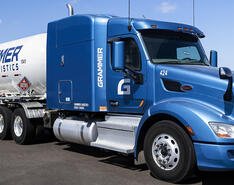
When I first started to insure propane companies, the loss control representative from Nobel Insurance — an insurance company once owned by the National Propane Gas Association — would stop by and tell us of claims he had seen in the field. These claims demonstrated the ignorance of people using propane back then.
- Farmers would fill their large tractor tires with liquid propane to give them more traction in the winter. They would forget about the propane in the tires and when one needed repair, the first swing of a sledgehammer resulted in a large explosion, causing injuries.
- How about the farmer who had to destroy a valuable cow after it stepped into a prairie dog hole and broke its leg? In his anger at the prairie dog burrows that were all over his pasture, the farmer took his propane tank mounted on a hay wagon and filled each and every burrow with a gallon or more of liquid propane. He then went back to his house and got a bow and arrow. He tied a rag filled with gas to an arrow, lit it on fire and shot it into the field. The result was a huge explosion, leaving his field useless and the farmer severely burned.
- Have you heard the story of the married couple who lived in a modular home? The house had a septic tank, and the wife complained to her husband that the septic tank was full. (Sounds like a line from the movie “Christmas Vacation”!) After complaining a number of times to her husband, he finally came up with a solution: He knew that propane is pressurized, and he had a propane tank mounted on a trailer that he used to burn the weeds that grew on the edge of the fields. He pulled the propane burner up to the back door, inserted the hose into the toilet and opened the valve on full. Sure enough, the propane blew the line clear. With a smile on his face, he told his wife of his success! With his wife appeased, he went into the bathroom and sat down on the stool and lit a cigarette. Need I say more?
Back then, the vast majority of claims were settled well under the $1 million limit of liability provided by the general liability policy.
Today, however, propane companies and the carriers that insure them are faced with drastically different situations — both good and bad. The number of uses for propane for more than just cooking and heating has grown. The portability of propane in smaller containers has opened the doors to using propane in more and more applications. Propane safety measures have also become much more sophisticated since those early days.
Conversely, the increase in propane usage opens up more opportunities for claims. Rules changing to allow lawyers to advertise has brought on the nuclear jury awards, which have dramatically impacted the insurance company’s profitability, resulting in higher insurance rates across the board. In an ongoing effort to protect themselves from large payouts, the insurance underwriters are constantly tightening the belt on safety protocols and, perhaps more importantly, documentation.
There are currently two requirements from these underwriters that are hot on their agendas.
First, they want a written record of every cylinder your company fills — not just cylinders needing recertification, but every single cylinder that your company fills. Period. In the event of a fire or explosion, if somebody sues your company, will your records prove you filled that cylinder? Or the reverse: Will your records show you did NOT fill that cylinder? The only way to comply is to collect the date filled and the serial number of the bottle and get the customer to sign off on the fill. These can either be handwritten logs or captured electronically through the propane-centric software systems out there.
Second, let’s review what is required if you have owned dispenser equipment located at a non-owned facility:
- You need a written and signed contract between your company and the operator and/or owner of that site where your dispenser is located. The contract should require the non-owned site to carry $1 million of liability coverage should an accident occur while their employee is filling the dispenser. Their coverage should be primary in responding to a claim, and the propane company should be shown as an additional named insured. It should also require the dispenser operator to insure the propane company’s dispenser equipment on a replacement cost basis.
- Your insurance company needs to be notified of each and every location where your dispensers are located to ensure they are properly covered under your general liability policy.
- If you have an owned dispenser off premises, you must train the employees at the non-owned location and keep a written record of your training.
I hear the groans, but this problem is getting bigger and bigger. Juries are awarding astronomical, multimillion-dollar settlements that are getting into the umbrella layers and driving everyone’s costs up. This has already caused multiple insurance companies to stop writing propane policies completely.
I started this article looking at propane insureds in the past. As we conclude by looking forward in 2025, insurance companies are firming up their loss control practices, requiring more sophisticated documentation from the propane companies, and they will not hesitate to cancel your insurance if you do not comply.



